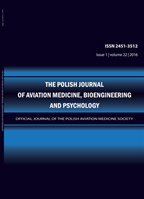2018, Volume 24, Issue 4
VOXEL-WISE ANALYSES OF THE IMPACT OF HIGH-FAT DIET ON BRAIN STRUCTURE IN WISTAR RATS
Piotr MAJKA1, Zuzanna SETKOWICZ2, Stefan P. GAŹDZIŃSKI3
-------------------------------------------------------------------------------------------------
1Nencki Institute for Experimental Biology, Polish Academy of Sciences
2Department of Neuroanatomy, Jagiellonian University
3Creative Neuroscience Lab – CNS Lab, Military Institute of Aviation Medicine
Autor korenspondencyjny: Stefan P. GAŹDZIŃSKI; Creative Neuroscience Lab – CNS Lab, Military Institute of Aviation Medicine; email: stefan.gazdzinski@yahoo.com
Full text
Streszczenie
Abstract: Recent studies at our institution have demonstrated an obesity problem among Helicopter Emergency Medical Service Pilots, similar to obesity problems encountered in other militaries. As obesity is associated with poorer cognitive performance, it may endanger mission objectives and safety of the crew. Maintaining lean body mass is important, but the effects of various nutrients on the brain and its performance have to be investigated in animal studies. Here, we discuss the methodological issues related to evaluation of this matter in animal (rat) models. Using ROI analyses, we have recently observed that a one-year application of high fat diet (HFD) that induced mild ketonemia lead to better learning and memory, larger hippocampi volumes, as well as spectroscopic changes consistent with these results in Wistar rats compared to regular chow (CON; Setkowicz et al., 2015). Here, we applied voxel-wise analysis to determine focal changes in brain tissue structure. Furthermore, we compared the effects of template selection (Valdés-Hernández et. al. template vs. study specific template) on the results.
Twenty five male Wistar rats were put on HFD (60% calories from fat, 28% from sugars and 7% from proteins) on their 55th day of life, while 25 CON remained on regular chow. Structural T2-weighted TurboRARE images were acquired at 7T. Eighteen datasets acquired for CON, 18 datasets for HFD were selected for analyses. Image of each specimen was registered into the Valdés-Hernández et. al. template or study-specific template created based on all the data.
Hippocampal volumes were larger in rats on the HFD than in controls, especially in the hippocampal CA1 field, but also in the surrounding cortical areas including entorhinal and temporal association cortex, regardless of the template used. Analysis with a study specific template does not show regions of smaller volumes in the HFD group compared to the CON.
The results confirm our ROI findings of larger hippocampal volumes in rats on the HFD, but also point to focal volume increases. Our results do not support the thesis that HFD per se does not necessarily lead to degeneration of the nervous system. They also point to the need of using a study specific template, as it is common in human studies.
Słowa kluczowe
magnetic resonance imaging, voxel-based morphology, template, high-fat diet, in-vivo, hippocampus, long-term effect
